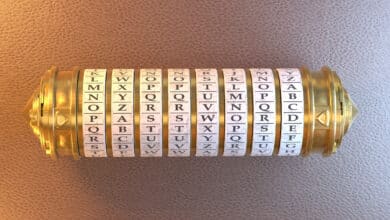Post-Quantum
PostQuantum.com by Marin Ivezic – Quantum Security, PQC, Quantum Resistance, CRQC, Q-Day, Y2Q
-
Ready for Quantum: Practical Steps for Cybersecurity Teams
The journey towards quantum resistance is not merely about staying ahead of a theoretical threat but about evolving our cybersecurity practices in line with technological advancements. Starting preparations now ensures that organizations are not caught off guard when the landscape shifts. It’s about being informed, vigilant, and proactive—qualities essential to…
Read More » -
Next-Generation QKD Protocols: A Cybersecurity Perspective
Traditional QKD implementations have demonstrated provably secure key exchange, but they come with practical limitations. To address these limitations, researchers have developed next-generation QKD protocols. These advanced protocols improve security by reducing trust assumptions and mitigating device vulnerabilities, and they enhance performance (key rate, distance) through novel techniques. The article…
Read More » -
Evaluating Tokenization in the Context of Quantum Readiness
As the quantum era approaches, organizations face the daunting task of protecting their sensitive data from the looming threat of quantum computers. These powerful machines have the potential to render traditional cryptographic methods obsolete, making it imperative to explore innovative strategies for quantum readiness. One often overlooked yet highly promising…
Read More » -
Quantum Computing – Looming Threat to Telecom Security
Since the early 2000s, the field of quantum computing has seen significant advancements, both in technological development and in commercialization efforts. The experimental demonstration of Shor's algorithm in 2001 proved to be one of the key catalyzing events, spurring increased interest and investment from both the public and private sectors.
Read More » -
Adiabatic Quantum Computing (AQC) and Impact on Cyber
Adiabatic Quantum Computing (AQC), and its variant Quantum Annealing, are another model for quantum computation. It's a specialized subset of quantum computing focused on solving optimization problems by finding the minimum (or maximum) of a given function over a set of possible solutions. For problems that can be presented as…
Read More » -
Entanglement-Based QKD Protocols: E91 and BBM92
While prepare-and-measure QKD currently leads the market due to simplicity and higher key rates, entanglement-based QKD protocols like E91 and BBM92 are at the heart of next-generation quantum communications. Ongoing improvements in photonic technology are steadily closing the gap in performance. The additional security guarantees (e.g., tolerance of untrusted devices)…
Read More » -
Quantum Key Distribution (QKD) and the BB84 Protocol
Quantum Key Distribution (QKD) represents a radical advancement in secure communication, utilizing principles from quantum mechanics to distribute cryptographic keys with guaranteed security.Unlike classical encryption, whose security often relies on the computational difficulty of certain mathematical problems, QKD's security is based on the laws of physics, which are, as far…
Read More » -
The Quantum Computing Threat
The secret sauce of quantum computing, which even Einstein called "spooky," is the ability to generate and manipulate quantum bits of data or qubits. Certain computational tasks can be executed exponentially faster on a quantum processor using qubits, than on a classical computer with 1s and 0s. A qubit can…
Read More » -
Challenges of Upgrading to Post-Quantum Cryptography (PQC)
The shift to post-quantum cryptography is not a distant problem but an imminent challenge that requires immediate attention. The quantum threat affects all forms of computing—whether it’s enterprise IT, IoT devices, or personal electronics. Transitioning to quantum-resistant algorithms is a complex, resource-intensive task that demands coordination across the supply chain,…
Read More » -
What’s the Deal with Quantum Computing: Simple Introduction
Quantum computing holds the potential to revolutionize fields where classical computers struggle, particularly in areas involving complex quantum systems, large-scale optimization, and cryptography. The power of quantum computing lies in its ability to leverage the principles of quantum mechanics—superposition and entanglement—to perform certain types of calculations much more efficiently than…
Read More » -
Introduction to Quantum Random Number Generation (QRNG)
Cryptographic systems rely on the unpredictability and randomness of numbers to secure data. In cryptography, the strength of encryption keys depends on their unpredictability. Unpredictable and truly random numbers—those that remain secure even against extensive computational resources and are completely unknown to adversaries—are among the most essential elements in cryptography…
Read More » -
Shor’s Algorithm: A Quantum Threat to Modern Cryptography
Shor’s Algorithm is more than just a theoretical curiosity – it’s a wake-up call for the security community. By understanding its principles and implications, we can appreciate why the cryptographic landscape must evolve. The goal of this guide is to equip you with that understanding, without delving into complex mathematics,…
Read More » -
Grover’s Algorithm and Its Impact on Cybersecurity
Grover’s algorithm was one of the first demonstrations of quantum advantage on a general problem. It highlighted how quantum phenomena like superposition and interference can be harnessed to outperform classical brute force search. Grover’s is often described as looking for “a needle in a haystack” using quantum mechanics.
Read More » -
Quantum-Safe vs. Quantum-Secure Cryptography
In 2010, I was serving as an interim CISO for an investment bank. During that time, I was already trying to figure out the risks posed by quantum computing. One day, I was approached by a vendor who, with great confidence, made two bold claims. First, they insisted that the…
Read More »













